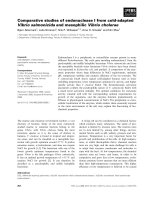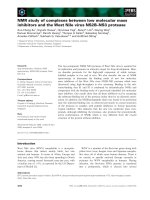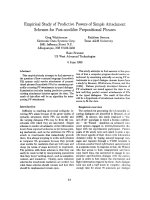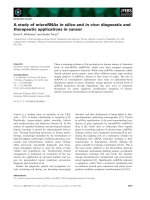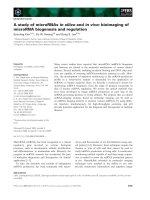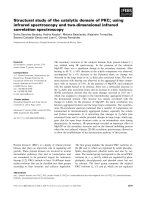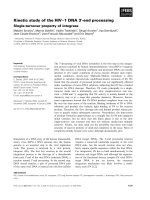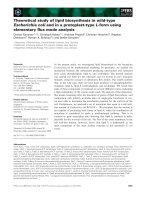Báo cáo khoa học: "Comparative study of endocrine cells in the principal pancreatic islets of two teleosts, Silurus asotus (Siluridae) and Siniperca scherzeri (Centropomidae)" potx
Bạn đang xem bản rút gọn của tài liệu. Xem và tải ngay bản đầy đủ của tài liệu tại đây (2.3 MB, 6 trang )
-2851$/ 2)
9HWHULQDU\
6FLHQFH
J. Vet. Sci. (2001),G2(2), 75–80
Comparative study of endocrine cells in the principal pancreatic islets of
two teleosts, Silurus asotus (Siluridae) and Siniperca scherzeri
(Centropomidae)
Jae-hyun Lee*, Sae-kwang Ku
1
, Ki-dae Park and Hyeung-sik Lee
2
Laboratory of Histology, College of Veterinary Medicine, Kyungpook National University, Taegu 702-701, Korea
1
Pharmacol & Toxicol Lab., Central Research Laboratories, Dong-Wha Pharm. Ind. Co, Anyang 430-017, Korea
2
Department of Biology, Faculty of Natural Sciences, Kyungsan University, Kyungsan 712-240, Korea
The regional distribution and relative frequency of some
endocrine cells in the principal pancreatic islets of two
teleosts,
Silurus asotus
Linne (Siluridae) and
Siniperca
scherzeri
Steindachner (Centropomidae), which have
similar feeding habits, were observed using specific
antisera against insulin, glucagon, somatostatin and
bovine pancreatic polypeptide (bovine PP) using the
peroxidase antiperoxidase (PAP) method. Spherical to
spindle shaped cells were demonstrated in the principal
pancreatic islets in both species of teleost fishes. However,
they were not detected in the exocrine portions nor the
pancreatic ducts. Insulin-immunoreactive cells were
located in the central regions of the principal pancreatic
islets at high frequency in both species. Glucagon-
immunoreactive cells were restricted to the peripheral
regions of the principal pancreatic islets in both species.
They formed a mantle zone in the peripheral regions of
Silurus asotus
with moderate frequency, and occupied a
narrower mantle zone in
Siniperca scherzeri
with
moderate frequency. In addition, glucagon-
immunoreactive cell cores were also found in the
peripheral zone of some principal pancreatic islets of
Siniperca scherzeri
. Somatostatin-immunoreactive cells
were dispersed in the central zone of the principal
pancreatic islets of
Silurus asotus
with moderate
frequency, but were located in the peripheral regions with
low frequency in
Siniperca scherzeri
. Bovine PP-
immunoreactive cells were found in the peripheral region
and the mantle zone of the principal pancreatic islets with
low and rare frequency, respectively in both species. In
conclusion, the regional distribution and relative
frequency of endocrine cells in the principal pancreatic
islets of
Silurus asotus
showed general patterns similar to
those of other teleostean fishes. But, some species-
dependent distributional patterns and/or relative
frequencies, particularly in glucagon-, somatostatin- and
bovine PP-immunoreactive cells, were detected in the
principal pancreatic islets of
Siniperca scherzeri
.
Key words:
Pancreas, teleosts,
Silurus asotus
,
Siniperca
scherzeri
, endocrine cell, immunohistochemistry, principal
pancreatic islets
Introduction
Catfish, Silurus asotus Linne, belonging to the Siluridae
in the order Siluriformes, are well recognized as stomach
teleost freshwater fish, which are dispersed worldwide.
Siniperca scherzeri Steindachner belonging to family
Centropomidae in the order Perciformes are also stomach
teleost freshwater fish but their habitations are limited to
Korea and a part of China.
It is generally known that the pancreas of vertebrates is
subdivided into two portions. One is exocrine where the
digestive enzymes are released and the other is endocrine,
where regulatory hormones such as insulin, glucagon,
somatostatin and pancreatic polypeptide (PP) are released
into the blood vessels. The appearance, regional
distribution and relative frequency of these regulatory
hormones secreted by endocrine cells in the pancreas are
well identified by histochemistry (Kobayashi and Ali,
1981), immunofluorescence (Orci, 1982) and
immunohistochemistry (Sternberger et al., 1970). In
addition to the above regulatory hormones, peptide YY-,
neuropeptide YY- (Ali-Rachedi et al., 1984), motilin-
(Yamada et al., 1986) and the chromogranin family- (Rindi
et al., 1986; Ito et al., 1987) immunoreactive cells have
also been demonstrated in the vertebrate pancreas. The
pancreas has been treated as a valuable organ for endocrine
studies and the endocrine pancreas has been extensively
*Corresponding author
Phone: +82-53-950-5970; Fax: +82-53-950-5955
E-mail:
76 Jae-hyun Lee et al.
studied in association with diabetes (Jansson and Sundler,
1988). Until now, investigations of the
gastroenteropancreatic (GEP) endocrine cells have been
considered to be an important part of a phylogenetic study
(D’Este et al., 1994).
The endocrine pancreas of teleost fish is mainly
composed of two types of pancreatic islets: 1) one, two or
even more multiple large islets, called principal pancreatic
islets and 2) numerous, widely scattered small islets
(Falkmer and Östberg, 1977). Although studies have
elucidated the regional distribution and relative frequency
of endocrine cells, immunoreactivity to antisera against
mammalian insulin, glucagon, somatostatin and PP, in the
pancreas of teleosts, localization of endocrine cells in the
principal pancreas of Silurus asotus and Siniperca
scherzeri have not yet been reported. In addition, the
localization of these endocrine cells within the pancreatic
islets and cell population seemed considerably variable
among species, especially in the case of PP-
immunoreactive cells (Yoshida et al., 1983). Among
teleosts, PP-immunoreactive cells, which were generally
demonstrated, were not detected in the pancreas of the
channel catfish and the lungfish (McNeill et al., 1984;
Hansen et al., 1987).
In the present study, the regional distribution and relative
frequency of endocrine cells in the principal pancreatic
islets of two species teleosts, Silurus asotus Linne
(Siluridae) and Siniperca scherzeri Steindachner
(Centropomidae) which have similar feeding habits, were
examined, using specific antisera against insulin,
glucagon, somatostatin and bovine PP by the peroxidase
antiperoxidase (PAP) method.
Materials and Methods
Each of five adult Silurus asotus Linne (Siluridae) and
Siniperca scherzeri Steindachner (Centropomidae) was
purchased from a merchant in Taegu, Korea and used in
this study without sexual distinction. After decapitation,
samples from the pancreas were fixed in Bouin's solution.
After paraffin embedding, 3-4 sections were prepared, and
representative sections of each tissue were stained with
hematoxylin and eosin for light microscopic examination
of the normal alimentary architecture.
Deparaffinized sections were rehydrated and submitted
for PAP (Sternberger, 1979). Background blocking was
performed with normal goat serum prior to incubation with
specific antisera (Table 1). After rinsing in phosphate
buffered saline (PBS, 0.01 M, pH 7.4), the sections were
incubated in secondary antiserum. They were then washed
in PBS buffer and finally the PAP complex was prepared.
The peroxidase reaction was carried out in a solution of
3,3’-diaminobenzidine tetrahydrochloride containing
0.01% H
2
O
2
in Tris-HCl buffer (0.05 M, pH 7.6). After
immunostaining, the sections were lightly counterstained
with Mayer’s hematoxylin and the immunoreactive cells
were observed under a light microscope.
Results
The principal islets were often clearly distinguishable in
the central, mantle and the peripheral regions by their
cellular composition. The regional distribution and relative
frequency of endocrine cells in the principal islets of two
species of teleostean fishes are summarized in Table 2.
Table 1.
Antisera used in this study
Antisera* Code Source Dilution
Insulin PUO290395 BioGenex, San Ramon 1 : 24
Glucagon PUO390699 BioGenex, San Ramon 1 : 20
Somatostatin PUO420198 BioGenex, San Ramon 1 : 20
Bovine pancreatic
polypeptide (bovine PP)
i607 UCB bioproducts, Drogenbos 1 : 5,000
*All antisera were raised in rabbits except for insulin which was raised in guinea pigs
Table 2.
Regional distribution and relative frequency of the endocrine cells in the principal pancreatic islets of two stomach teleostean
fishes,
Silurus asotus
and
Siniperca scherzeri
Hormones
Silurus asotus Siniperca scherzeri
Central region Mantle zone
Peripheral
region
Central region Mantle zone
Peripheral
region
Insulin +++
−−
+++
−−
Glucagon
−
++
±−±
++
Somatostatin ++
±±−±
+
Bovine pancreatic polypeptide
−±
+
±±
+
+++: numerous, ++: moderate, +: a few,
±
: rare,
−
: not detected.
Endocrine cells in the pancreas of two teleosts 77
Spherical to spindle shaped immunoreactive cells having
cytoplasmic process were demonstrated in the pancreatic
islets, but no cells were detected in the exocrine portions
nor the pancreatic ducts. Different distribution patterns of
these immunoreactive cells, especially glucagon- and
somatostatin-immunoreactive cells, were shown by the
principal pancreases of the two species.
Endocrine cells in the principal pancreatic islets of
Silurus asotus
Insulin-immunoreactive cells were located in the central
regions of the principal pancreatic islets with high
frequency, forming central cores. However, no insulin-
immunoreactive cells were detetcted in the mantle and
peripheral regions (Figs. 1A and B). Glucagon-
immunoreactive cells were situated in the peripheral
regions and formed a two to five cell thickness mantle
zone, at relatively lower frequency than that of insulin-
immunoreactive cells (Figs. 1C and D). Somatostatin-
immunoreactive cells were randomly dispersed in the
central regions with moderate frequency and their
cytoplasmic processes were extended among the insulin-
immunoreactive cells in that region. In addition, rarely
somatostatin-immunoreactive cells were also found in the
mantle zone and peripheral regions. In the mantle zone
where most of glucagon-immunoreactive cells were
situated, their cytoplasmic processes extended among the
glucagon- and bovine PP-immunoreactive cells, and
similar distributional patterns were seen in the peripheral
zone, which was mainly occupied by bovine PP-
immunoreactive cells (Figs. 1E and F). Bovine PP-
immunoreactive cells were detected in the peripheral
regions of the principal pancreas, and a small number of
cells were also observed in the mantle zone where their
cytoplasmic processes extended between the large mass of
glucagon-immunoreactive cells (Figs. 1G and H).
Endocrine cells in the principal pancreatic islets of
Siniperca scherzeri
Insulin-immunoreactive cells were situated in the central
regions of the principal pancreatic islets with sufficient
frequency to form a central core. However, no insulin-
immunoreactive cells were detetcted in the mantle and
peripheral regions (Figs. 2A and B). Glucagon-
immunoreactive cells were located in the peripheral
regions and formed a one to two cell thickness mantle zone
in these region with relatively lower frequency than that of
the insulin-immunoreactive cells. In addition, glucagon-
immunoreactive cell cores, which consisted of numerous
cells, were also found in the peripheral zone of some
principal pancreatic islets (Figs. 1C and D). Somatostatin-
immunoreactive cells were restricted to the mantle and
peripheral regions at rare and low frequencies,
respectively, and their cytoplasmic processes extended
among the glucagon- and bovine PP-immunoreactive cells
in these regions (Figs. 1E and F). Bovine PP-
immunoreactive cells were detected in the regions similar
to those of glucagon-immunoreactive cells, but their
relative frequencies in these regions was somewhat lower
than that of the glucagon-immunoreactive cells. In that
regions, their cytoplasmic processes were extended
between glucagon-immunoreactive cells. In addition,
endocrine cells were also rarely distributed in the central
regions, which were occupied by numerous insulin-
immunoreactive cells (Figs. 1G and H).
Fig. 1. Immunoreactive cells in the principal pancreatic islets o
f
the Silurus asotus. Insulin-immunoreactive cells were located in
the central region (A and B). Glucagon-immunoreactive cells
surrounded the central regions, where insulin- and somatostatin-
immunoreactive cells were located, and formed a mantle zone (C
and D). Somatostatin-immunoreactive cells were observed in the
central regions, intermingled with insulin-immunoreactive cells
(E and F). Bovine pancreatic polypeptide-immunoreactive cells
were situated in the peripheral regions and occasionally in the
mantle zone, intermingled with glucagon-immunoreactive cells
(G and H). A, C-E, G: ×175; B, F,H: ×350. PAP method.
78 Jae-hyun Lee et al.
Discussion
This study revealed that the principal pancreatic islets of
the two species of teleostean fishes, having similar feeding
habits, contained insulin-, glucagon, somatostatin- and
bovine PP-immunoreactive cells. In the present study,
somewhat different distributional patterns of these four
types of immunoreactive cells were observed in the two
species. In addition, species-dependent distributional
patterns were also observed, especially for the
somatostatin- and bovine PP-immunoreactive cells.
Insulin is synthesized in the B cells of the pancreatic
islets and regulates the serum glucose levels (Hsu and
Crump, 1989). The regional distribution and relative
frequency of the insulin-immunoreactive cells in the
pancreas of numerous teleosts have been reported in the
lungfish (Hansen et al., 1987), flatfish (Yoshida, 1983),
gilt-head sea bream (Guyot et al., 1998), five species of
osteoglossomorpha, an ancient teleostean group (Al-
Mahrouki and Youson, 1998), Protopterus annectens
(Tagliafierro et al., 1996), dipnoan fish (Scheuermann et
al., 1996), anglerfish and channel catfish (Johnson et al.,
1976). From these previous reports, it seems to be a
general rule that in the pancreatic islets of teleosts, insulin-
immunoreactive cells occur in the central regions and our
results correspond well in these respect to previous reports
(Johnson et al., 1976; Yoshida, 1983; Hansen et al., 1987;
Scheuermann et al., 1996; Tagliafierro et al., 1996; Al-
Mahrouki and Youson, 1998; Guyot et al., 1998), insulin-
immunoreactive cells were found in the central regions of
the principal pancreatic islets of both species in the present
study.
Glucagon is synthesized in the A cells of the pancreas
and regulates glucose levels in the blood (Hsu and Crump,
1989). Morphologically similar cells are also observed in
the digestive tract of the dog. The regional distribution and
relative frequency of glucagon-immunoreactive cells in the
teleostean pancreas have been reported in the flatfish
(Yoshida et al., 1983), Carp (Rombout et al., 1986), five
species of osteoglossomorpha, and an ancient teleostean
group (Al-Mahrouki and Youson, 1998), gar (Groff and
Youson, 1997), Protopterus annectens (Tagliafierro et al.,
1996), dipnoan fish (Scheuermann et al., 1996), anglerfish
and channel catfish (Johnson et al., 1976), and
Xiphophorus helleri (Klein and Van Noorden, 1980). It
also seems to be a general rule in the pancreatic islets of
teleosts that glucagon-immunoreactive cells occur in the
peripheral regions and that they form a small mantle zone
or rim surrounding centrally located insulin-
immunoreactive cells except in the case of
osteoglossomorpha, which shows a scattered
immunoreactivity throughout the central portion of the
islets in addition to the common peripheral regions. In the
present study, glucagon-immunoreactive cells were found
to be located in the peripheral regions of the principal islets
of both species and formed a two to five (in Silurus asotus)
or one to two (in Siniperca scherzeri) cell thickness mantle
zone. These results were similar to those of previous
studies (Johnson et al., 1976; Klein and Van Noorden,
1980; Yoshida et al., 1983; Rombout et al., 1986;
Scheuermann et al., 1996; Tagliafierro et al., 1996; Groff
and Youson, 1997). However, cell masses consisting of
numerous glucagon-immunoreactive cells were also found
in the principal pancreatic islets of Siniperca scherzeri,
which were restricted in some islets. These findings are
considered to represent a species-dependent unique
Fig. 2.
Immunoreactive cells in the principal pancreatic islets o
f
Siniperca scherzeri
. Insulin-immunoreactive cells were located
in the central region (A and B). Glucagon-immunoreactive cells
surrounded the central regions, where insulin-immunoreactive
cells were located, and formed a mantle zone. In addition,
glucagon cells masses were also detected in some islets (C and
D). Somatostatin-immunoreactive cells were demonstrated in the
peripheral regions, intermingled with bovine pancreatic
polypeptide- and glucagon-immunoreactive cells (E and F).
Bovine pancreatic polypeptide-immunoreactive cells were
situated in the peripheral regions and occasionally in the mantle
zone, intermingled with glucagon- and somatostatin-
immunoreactive cells (G and H). A-H:
×
175. PAP method.
Endocrine cells in the pancreas of two teleosts 79
distributional pattern. In addition, the cell layer of the
mantle zone also differed in the two species.
Somatostatin, which consists of 14 amino acids, was
isolated from the hypothalamus of sheep, and exists in
straight and cyclic forms (Brazeau et al., 1973). This
substance inhibits the secretion of the gastrin,
cholecystokinin, secretin, glucagon, insulin, motilin and
gastric acid (Kitamura et al., 1984) and the absorption of
amino acid, glucose and fatty acid in the gastrointestinal
tract (Brazeau et al., 1973). Somatostatin-immunoreactive
cells of the teleostean islets have been reported to be
dispersed mainly in the central region, intermingled with
insulin-immunoreactive cells (Stefan and Falkmer, 1980;
Rombout and Taverne-Thiele, 1982). However, Yoshida et
al. (1983) suggested that somatostatin-immunoreactive
cells occur in the peripheral regions of islets intermingled
with insulin cells, in addition to the central regions, and
similar distributional patterns have also been seen in
Protopterus annectens (Tagliaflerro et al., 1996). In
addition, Scheuermann et al. (1991) reported that
somatostatin-immunoreactive cells were scattered
throughout the islets of dipnoan fish. Although in the
present study somatostatin-immunoreactive cells in the
principal pancreatic islets of Silurus asotus were found to
be located in the central regions, which in similar to
previous reports (Stefan and Falkmer, 1980; Rombout and
Taverne-Thiele, 1982), in Siniperca scherzeri, they were
restricted to the peripheral regions with glucagon- and
bovine PP-immunoreactive cells. This is considered to be
an unique distributional pattern of Siniperca scherzeri.
PP-immunoreactive cells, the fourth cell type, were
demonstrated first by Stefan et al. (1978) and Van Noorden
and Patent (1978) in the pancreas of some teleosts. Later, it
was revealed that PP-immunoreactive cells were
conspicuously variable in distribution among species,
although the cells, if they occured, were always located in
the peripheral regions of the pancreatic islets. PP-
immunoreactive cells were detected in the principal
pancreas of Cottus scorpius (Stefan and Falkmer, 1980),
Barbus conchonius (Rombout and Taverne-Thiele, 1982),
Xiphophorus helleri (Klein and Van Noorden, 1980),
anglerfish (Johnson et al., 1982), flatfish (Yoshida et al.,
1983), five species of osteoglossomorpha, an ancient
teleostean group (Al-Mahrouki and Youson, 1998) and gar
(Groff and Youson, 1997). However, no PP-
immunoreactive cells were found in the pancreas of the
channel catfish (McNeill et al., 1984) and lungfish
(Hansen et al., 1987). In the present study, and as has been
found in other teleostean fishes (Stefan et al., 1978; Van
Noorden and Patent, 1978; Klein and Van Noorden, 1980;
Stefan and Falkmer, 1980; Johnson et al., 1982; Yoshida et
al., 1983; Groff and Youson, 1997; Al-Mahrouki and
Youson, 1998), bovine PP-immunoreactive cells were
mainly distributed in the peripheral regions of the principal
pancreatic islets of both species with glucagon-
immunoreactive cells and occasionally with somatostatin-
immunoreactive cells. However, rarely cells were
dispersed in the central regions of pancreatic islets of
Siniperca scherzeri, which was considered to be a species-
dependent distributional patterns.
In conclusion, the regional distribution and relative
frequency of insulin-, glucagon-, somatostatin- and bovine
PP-immunoreactive cells in the principal pancreatic islets
of Silurus asotus showed the general patterns observed in
teleostean fishes, but some species-dependent
distributional patterns and/or relative frequencies,
particularly in glucagon-, somatostatin- and bovine PP-
immunoreactive cells, were detected in the principal
pancreatic islets of Siniperca scherzeri.
Acknowledgment
This research was supported by Kyungpook National
University Research Fund, 2000.
References
1.
Alli-Rachedi, A., Varndell, I. M., Adrian, T. E., Gapp, D.
A., Van Noorden, S., Bloom, S. R. and Polak, J. M.
Peptide
YY (PYY) immunoreactivity is co-stored with glucagon-
related immunoreactants in endocrine cells of the gut and
pancreas. Histochemistry 1984,
80
, 487-491.
2.
Al-Mahrouki, A. A. and Youson J. H.
Immunohistochemical studies of the endocrine cells within
the gastro-entero-pancreatic system of Osteoglossomorpha,
an ancient teleostean group. Gen. Comp. Endocrinol. 1998,
110
, 125-139.
3.
Brazeau, P., Vale, W., Burgurs, R., Ling, N., Butcher, M.,
Rivier, J. and Guillermin, R.
Hypothalamic polypeptide
that inhibits the secretion of immunoreactive pituitary growth
hormone. Science 1973,
179
, 77-79.
4.
D’Este, L., Buffa, R., Pelagi, M., Siccardi, A. G. and
Renda, T.
Immunohistochemical localization of
chromogranin A and B in the endocrine cells of the
alimentary tract of the green frog,
Rana esculanta
. Cell
Tissue Res. 1994,
277
, 341-349.
5.
Falkmer, S. and Östberg, Y.
Comparative morphology of
pancreatic islets in animals. In: Volk BW, and Wellmann KF
(ed), The diabetic pancreas. pp. 15-59, Plenum Press, New
York, 1977.
6.
Groff, K. E. and Youson, J. H.
An immunohistochemical
study of the endocrine cells within the pancreas, intestine,
and stomach of the gar. Gen. Comp. Endocrinol. 1997,
106
,
1-16.
7.
Guyot, E., Diaz, J. P., Romestand, B. and Connes, R.
Insulin during the early postembryonic development of the
gilt-head sea bream,
Sparus aurata
: ultrastructural,
immunohistochemical, and biochemical studies. Gen. Comp.
Endocrinol. 1998,
110
, 147-156.
8.
Hansen, G. N., Hansen, B. L. and Jorgensen, P. N.
80 Jae-hyun Lee et al.
Insulin-, glucagon- and somatostatin-like immunoreactivity
in the endocrine pancreas of the lungfish,
Neoceratodus
forsteri
. Cell Tissue Res. 1987,
248
, 253-261.
9.
Hsu, W. H. and Crump, M. H.
The endocrine pancreas. In:
McDonald L. E., and Pineda M. H. (ed), Veterinary
endocrinology and reproduction, pp. 186-201, Lea &
Febiger, Philadelphia, 1987.
10.
Ito, H., Hashimoto, Y., Kitagawa, H., Kon, Y. and Kudo,
N.
Distribution of chromogranin containing cells in the
porcine gastroenteropancreatic endocrine system. Jpn. J. Vet.
Sci. 1987,
50
, 395-404.
11.
Jansson, L. and Sandler, S. L.
The influence of cyclosporin
A on the vascular permeability of the pancreatic islets and on
diabetes induced by multiple low dose of streptozotocin in
the mouse. Virchows Arch. A Pathol. Anat. Histopathol.
1988,
412
, 225-230.
12.
Johnson, D. E., Noe, B. D. and Bauer, G. E.
Pancreatic
polypeptide (PP)-like immunoreactivity in the pancreatic
islets of the anglerfish (
Lophius americanus
) and the channel
catfish (
Ictalurus punctata
). Anat. Rec. 1982,
204
, 61-67.
13.
Johnson, D. E., Torrence, J. L., Elde, R. P., Bauer, G. E.,
Noe, B. D. and Fletcher, D. J.
Immunohistochemical
localization of somatostatin, insulin and glucagon in the
principal islets of the anglerfish (
Lophius americanus
) and
the channel catfish (
Ictalurus punctata
). Am. J. Anat. 1976,
147
, 119-124.
14.
Kitamura, N., Yamada, J., Calingasan, N. Y. and
Yamashita, T.
Immunocytochemical distribution of
endocrine cells in the gastrointestinal tract of the horse.
Equine Vet. J. 1984,
16
, 103-107.
15.
Klein, C. and Van Noorden, S.
Pancreatic polypeptide (PP)-
and glucagon cells in the pancreatic islets of
Xiphophorus
helleri
H. (Telecostei). Correlative immunohistochemistry
and electron microscopy. Cell Tissue Res. 1980,
205
, 187-
198.
16.
Kobayashi, K. and Ali, S. S.
Cell types of the endocrine
pancreas in the shark, Scylliorhinus stellaris as revealed by
correlative light and electron microscopy. Cell Tissue Res.
1981,
215
, 475-490.
17.
McNeill, D. L., Brinn, J. E. and Hetcher, D. J.
Immunocytochemical study of the pancreatic islet system of
the channel catfish. Anat. Rec. 1984,
209
, 381-384.
18.
Orci, L.
Macro- and micro-domains in the endocrine
pancreas. Diabetes 1982,
31
, 538-564.
19.
Rindi, G., Buffa, R., Sessa, F., Tortora, O. and Solcia, E.
Chromogranin A, B and C immunoreactivities of mammalian
endocrine cells: Distribution from costored hormones/
prohormones and relationship with argyrophil component of
secretory granules. Histochemistry 1986,
85
, 19-28.
20.
Rombout, J. H. W. M. and Taverne-Thiele, J. J.
Immunocytochemical and electron-microscopical study of
endocrine cells in the gut and pancreas of a stomachless
teleost fish,
Barbus conchonius
(Cyprinidae). Cell Tissue
Res. 1982,
227
, 577-593.
21.
Rombout, J. H. W. M., Van der Grinten, C. P. M., Peeze
Binkhorst, F. M., Taverne-Thiele, J. J. and Schooneveld,
H.
Immunocytochemical identification and localization of
peptide hormones in the gastro-entero-pancreatic (GEP)
endocrine system of the mouse and a stomachless fish,
Barbus conchonius. Histochemistry 1986,
84
, 471-483.
22.
Scheuermann, D. W., Adriaensen, D., Timmermans, J. P.
and De Groodt-Laseel, M. H.
Immunohistochemical
localization of polypeptide hormones in pancreatic endocrine
cells of a dipnoan fish,
Protopterus aethiopicus
. Acta.
Histochem. 1991,
91
, 185-192.
23.
Stefan, Y., Dufour, C. and Falkmer, S.
Mise en vidence par
immunofluorescence de cellules polypeptide pancr atique
(PP) dans le pancr as et le tube digestif de poissons osseux et
cartilagineux. C. R. Acad. Sci. 1978,
286
, 1073-1075.
24.
Stefan, Y. and Falkmer, S.
Identification of four endocrine
cell types in the pancreas of
Cottus scorpius
(Teleostei) by
immunofluorescence and electron microscopy. Gen. Comp.
Endocrinol. 1980,
42
, 171-178.
25.
Sternberger, L. A.
The unlabeled antibody peroxidase-
antiperoxidase (PAP) method. In: Sternberger L. A. (ed),
Immunocytochemistry, pp. 104-169, John Wiley & Sons,
New York, 1979.
26.
Sternberger, L. A., Hardy, P. H., Cuculis, J. J. and Meyer,
H. G.
The unlabeled antibody enzyme method of
immunocytochemistry: Preparation and properties of soluble
antigen-antibody complex (Horseradish peroxidase-
antihorseradish peroxidase) and use in identification of
spirochetes. J. Histochem. Cytochem. 1970,
18
, 315-333.
27.
Tagliafierro, G., Carlini, M., Faraldi, G., Morescalchi, A.
M., Putti, R., Della Rossa, A., Fasulo, S. and Mauceri, A.
Immunocytochemical detection of islet hormones in the
digestive system of Protopterus annectens. Gen. Comp.
Endocrinol. 1996,
102
, 288-298.
28.
Van Noorden, S. and Patent, G. J.
Localization of
pancreatic polypeptide (PP)-like immunoreactivity in the
pancreatic islets of some teleost fishes. Cell Tissue Res.
1978,
188
, 521-525.
29.
Yamada, J., Campos, V. J. M., Kitamura, N., Pacheco, A.
C., Yamashita, T. and Yanaihara, N.
An
immunohistochemical study of endocrine cells in the
pancreas of
Caiman latirostris
(Alligatorinae), with special
reference to pancreatic motilin cells. Biomed. Res. 1986,
7
,
199-208.
30.
Yoshida, K., Iwanaga, T. and Fujita, T.
Gastro-entero-
pancreatic (GEP) endocrine system of the flatfish,
P
aralichtys olivaceus
: An immunocytochemical study. Arch.
Histol. Jap. 1983,
46
, 259-266.
